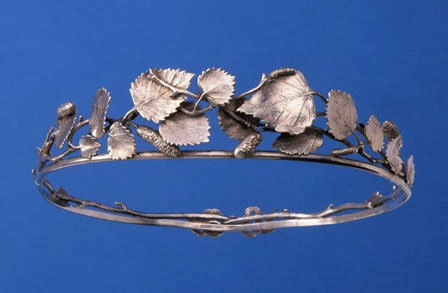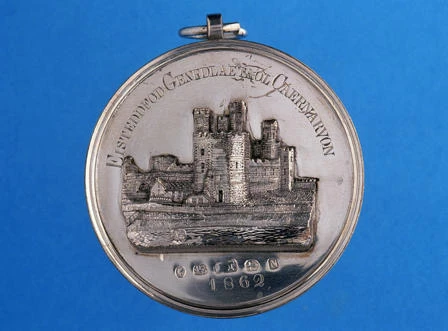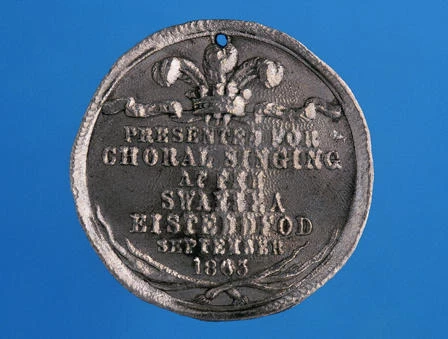The Beginnings of the National Eisteddfod
By the time we reach the end of this exciting movement with the last of the Abergavenny eisteddfodau in 1853, it's obvious that the Eisteddfod is on the threshold of a particularly exciting period. By then there were railways the length and breadth of Wales, and this made it possible to bring thousands of people from every part of Wales to the different venues where the eisteddfodau were held. A new era had dawned, and by the middle of the 1850s people were beginning to talk of a National Eisteddfod. The time had come to create one single eisteddfod, yearly, if possible, that would encapsulate Wales's eisteddfod culture on an annual basis.
What part did that culture have to play in upholding Welsh morale, Welsh spirits? By the time we come to the 1850s, the Eisteddfodau are in the shadow of the Blue Books. The Blue Books appeared in 1846/7 and launched a notorious attack on the character of the Welsh as a nation, finding them lacking in the extreme. From 1847 onwards it's as clear as day that it has become extremely important for the Welsh to create a new national image, an image that would defend their reputation and show that they were a nation deserving of approbation rather than insults. To promote such an image, well, you needed a stage or, if you like, a shop window, so you could tell the world that you'd been hard done by, and deserved better.
By the 1850s discussion was rife, for you had no other national institution that could stage a compensatory image of that kind. Talk of a National Eisteddfod began in earnest, and in 1858 something wonderful happened. Another of the clergy, John Williams ab Ithel, a man who was intoxicated by the ideas of Iolo Morgannwg, and believed one hundred percent in the Gorsedd of Bards, and a man with quite a bit of the entrepreneur about him too, saw the significance of the coming of the train. He decided to hold an eisteddfod complete with Gorsedd in Llangollen in September 1858, one that would be, if not exactly a proper National Eisteddfod, then certainly a prefiguring of what a National Eisteddfod might be like.
The Great Llangollen Eisteddfod, 1858
The great Llangollen Eisteddfod of 1858 is a highly significant event. It was a tempestuous eisteddfod. It was at this eisteddfod that the famous Thomas Stephens of Merthyr entered his wonderful essay exploding the myth of Madog's discovery of America. John Williams and his friends had been expecting an essay which would reinforce the myth. Because it had been discredited, they were not at all willing to award the prize to Thomas Stephens and matters at this Eisteddfod became turbulent in the extreme.
And of course, this Eisteddfod saw the first public appearance of a young poet who would be the idol of the nation until his death in the year 1887: none other than Ceiriog, John Ceiriog Hughes. He travelled all the way from Manchester, where he was living at the time, to collect his prize for a love poem, 'Myfanwy Fychan of Dinas Brân'. 'Myfanwy Fychan' was the most amazing 'hit' from the moment it was first read at the Great Llangollen Eisteddfod. In my opinion there's one overriding reason for this. The women of Wales had been pilloried In the dreadful Blue Books of 1847. Their morals had been called into question; it was said that illegitimate children were two a penny in Wales, and this had cut the Welsh to the quick. What Ceiriog did above all else in 1858 in Llangollen was to create an image of a deserving, beautiful, moral, well-mannered Welshwoman, and the Welsh fell in love with Myfanwy Fychan overnight.
Establishing a National Body, 1860
From the great Llangollen Eisteddfod of 1858 we move to the 1860 eisteddfod in Denbigh. It was here that the decision was made to establish a national body, to be called The Eisteddfod. This body would have an Executive Committee called the Council, whose members would be elected. It was this body which went on to create an official National Eisteddfod, to be held in the North and the South in alternate years. And that's exactly what happened.
The first official National Eisteddfod was held in Aberdare in 1861. From Aberdare it went to Caernarfon in '62, to Swansea in '63, to Llandudno in '64, to Aberystwyth in '65, out to Chester in 1866, back to Carmarthen in '67, ending its journey in Ruthin in 1868 for the simple reason that the National Eisteddfod was in debt. These were the first modern National Eisteddfodau, and they've left their mark on the National Eisteddfod to this day...
...But there's no doubt at all of the importance of the National Eisteddfodau of the 1860s. They were big eisteddfodau, raising a pavilion to seat between eight and ten thousand people every year, the trains bringing the crowds in their thousands to North and South, and the great choirs, of course, followed everywhere in those days, exactly as rugby and soccer teams would be in later years. These are large, exciting Eisteddfodau, full of controversy, full of hopes and fears, and they are particularly important to any understanding of Welsh-language culture in the modern period.
Aberdare, 1861: Dafydd Morgannwg's medal
We have chosen three medals from the Museum's collection. One of them is this striking medal from the first National Eisteddfod in Aberdare in 1861. It belonged to the famous Dafydd Morgannwg, David Jones, who won this medal for an essay on the history of Glamorganshire. It was published and is still a very important book today. Incidentally, the Prince of Wales feathers on this fine medal tell us a great deal about the way the Welsh longed for the royal family's seal of approval on their activities.
Caernarfon, 1862: the Prince of Wales's cantata
This 1862 medal is Owen Alaw's. He won it for composing a cantata, one of those compositions that were amazingly important in the 1860s - the Prince of Wales cantata. Owen Alaw composed the music, Ceiriog wrote the words and the cantata was performed at the National Eisteddfod in Swansea in 1863, with the pavilion packed to capacity. Of course they sang the pop song of the day during the performance, that is, God Bless the Prince of Wales (he had just celebrated his twenty-first birthday, of course). It was Ceiriog, more than anyone, who was responsible for staging that song during the performance in Swansea, and Brinli Richards, the brilliant pianist from Carmarthen, who composed the melody for God Bless the Prince of Wales, and he, and the harpist Pencerdd Gwalia, were both regal figures at the first National Eisteddfodau.
Swansea, 1863: the rise of Welsh choral singing
In 1863, too, you see for the first time a medal being won for choral singing. In that eisteddfod two choirs came face to face - the Cymdeithas Cwm Tawe choir, conducted by Evander Griffiths, and the Aberdare Choral Society under Silas Evans: the first great contest. And there, witnessing it all, was H.F. Chorley, the music correspondent of the Athenaeum, and when Chorley said he'd been dazzled by the standard of the choral singing - because the members of the two choirs he heard in 1863 were mostly miners and their families - and that he couldn't think of more than six choral societies in England who could compete with them, well of course the cup of the Welsh was overflowing. And from that time on you see the National Eisteddfod putting all its eggs in the same basket, with the choirs and soloists. It was they who brought the Welsh renown.
The Eisteddfod and the Welsh Language
These early National eisteddfodau under the auspices of the Eisteddfod and its Council are quite amazing and have left their mark on the Eisteddfod to this day. It was during these eisteddfodau in the 1860s, by the way, that you saw the English language literally overtaking Welsh. One of the saddest things in the history of the Eisteddfod is the way in which the first National Eisteddfod was turned into a kind of English Eisteddfod, mainly because the Welsh were living so much in the shadow of the Blue Books and were longing, really, to be considered as representatives of a progressive nation. The early National Eisteddfod was colonised by the English language and by the culture of the concert hall. It was the concerts and the choirs and the soloists who counted above all.
This is where the famous Hugh Owen, later Sir Hugh Owen, comes into the story. Here was a man who longed above all to establish a national system of education in Wales, and he worked remarkably energetically to do so. Of course, what he had in mind was an education system dominated by the English language. Hugh Owen came to the Eisteddfod in Aberdare in 1861 and saw the remarkable possibilities it offered for propagandising for a national system of education. In Caernarfon in 1862, he added a completely new section to the Eisteddfod, calling it simply the 'Social Science Section', where all aspects of life in Wales would be discussed, mainly through the medium of English. Every aspect possible: her religion and morals, her education, her industries, with the emphasis firmly on improving living standards in Wales.
And so, through the culture of the concert, and the influence of Hugh Owen's Social Science Section, you see the English language infiltrating every part of the National Eisteddfod. It's very important that we should realise this, because in fact, down to the year 1950 when the Welsh rule, or as the Archdruid Cynan called it, the Welsh principle, came into operation in Caerphilly, the English language was more prominent, really, on the stage of the National Eisteddfod than the Welsh language. Up until then, for the greater part of a century Welsh had been fighting for its life on the stage of the National Eisteddfod, and we should remember that.
It's only comparatively recently that we can refer to the Eisteddfod as a kind of bastion of the Welsh language. Up until 1950, from 1861 to 1950, Welsh at the National Eisteddfod had been fighting for its life against the 'progressives' who feared that the English (Who else? They were the great nation next door who counted) still considered the Welsh to be a little people who lived, as the Blue Books had it, 'under the hatches'. The story of that fight is quite central to the story of Welsh-language culture in the twentieth century.


